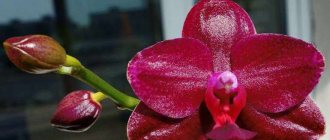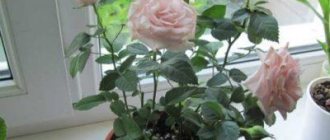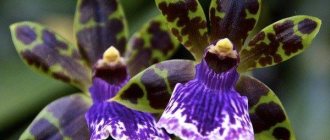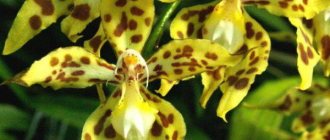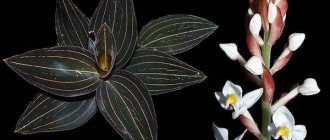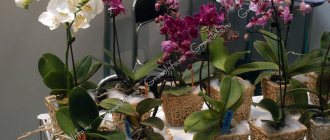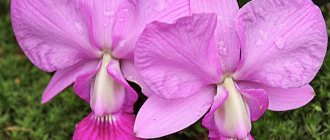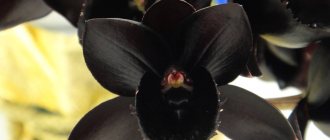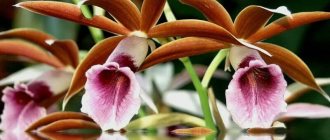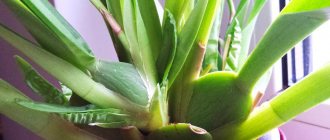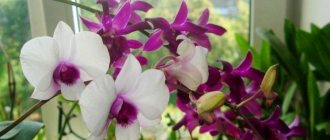The structure of orchid leaves
The orchid leaf is covered with a top layer - the skin (Epidermis), consisting of living cells.
The lower part covers the stem and forms the leaf axil. Protects the stem from damage. The base is usually thickened.
In orchids, leaves are most often located:
- alternately (one sheet is higher than the other);
- opposite (one sheet opposite the other).
The skin allows sunlight to reach the inner layers and protects the leaf from excessive moisture loss.
There may be hairs on the surface that protect against excessive overheating.
Depending on the place where orchids grow, the epidermis contains stomata from the bottom of the leaf and from both sides.
Stomata play an important role:
- evaporate water;
- regulate gas exchange;
- control the intensity of water evaporation;
- rate of photosynthesis.
The rate of evaporation depends on air humidity. The higher the humidity in the room, the less evaporation will occur.
When water evaporates, the orchid's temperature decreases and this protects the plant from overheating and regulates the flow of microelements from the roots to the leaves.
The faster evaporation occurs , the faster the process of photosynthesis .
An orchid can shed its leaves due to excessive loss of moisture in very dry climates. Also, together with them, it removes harmful breakdown products of substances that accumulate in the leaves.
In the upper layer of the epidermis there are tissue cells and intercellular spaces that are filled with air. The intercellular spaces are connected to the stomata and perform gas exchange and transpiration.
Cells store nutrients, sugar and starch. Vessels pass through the tissues - tubes through which substances formed during the process of photosynthesis flow.
The cells contain a large number of chloroplasts, in which the intensive process of photosynthesis occurs .
A sharp decrease in temperature from warm to cold leads to the destruction of chlorophyll . Therefore, the leaves may change their color.
As a rule, the drier the area where the crop grows, the denser the green mass, since it is this that maintains the level of moisture and nutrients.
The structure of the leaves and their location on the sunny side may differ from the location on the shady side.
Leaves growing on the sunny side are more elastic and dense. This is due to the fact that they need to withstand direct sunlight.
How to prune correctly?
Vanilla orchid needs pruning. If it is absent, the vine will only grow in length, as a result of which the appearance of the flower will be unaesthetic.
You can trim the plant at any distance. It is possible to trim at the very root or eliminate excess shoots. The plant will branch where it is cut. In this way, you can adjust the appearance of the flower, gradually turning it into a uniformly fluffy green bush. Thanks to the structural features of the orchid, the branches of the vine can be entwined with decorative structures of various sizes, giving Vanilla an original shape.
If you provide the Vanilla Orchid with the required conditions, careful care and love, the flower will respond to you with lush green leaves and 20-30 flowers with a subtle aroma of vanilla.
Functions of leaves
In sympodial orchids, nutrients accumulate in bulbs (pseudobulbs), and for monopodial species, this role is played by leaves.
Functions of orchid leaves:
- photosynthesis;
- evaporation of water (transpiration);
- gas exchange;
- accumulation of nutrients.
The growth of leaves is limited to a certain size, unlike the roots and the stem itself.
The lifespan of leaves is different for each species. On average, leaves change from one to three per year. The old ones begin to turn yellow from the edges and gradually fade and dry out.
The dying process takes from one to several months.
How to replant a plant?
Vanilla needs to be replanted no more often than once every 2-3 years. Moreover, replanting is necessary only for those orchids whose roots no longer fit in the pot. The procedure should be carried out in the spring. During transplantation, the flower is carefully removed from the old container and placed in a new one, carefully covering the root part with soil substrate. In this case, you should be careful not to break the roots. If one of them does break, it is placed in a pot and sprinkled with crushed charcoal.
Important! If an overgrown plant is not replanted for a long time, its growth may slow down.
What leaf color is abnormal?
The color of orchid leaves is green, the shade depends on the variety and living conditions of the plant, but green is always a healthy color.
- Yellowing indicates that the plant is withering or drying out. This may be due to improperly selected care. Also, too much fertilizer can cause yellowing of the leaves.
- Purple spots indicate that the orchid has been exposed to the sun for a long time and has received a sunburn.
- A red tint indicates that there is excessive lighting in the room.
- A brown color is a sure sign that the plant is infected with a disease.
- White or discolored areas with a brown outline indicate sunburn.
- Light areas that then begin to turn red may indicate the presence of a disease such as rust.
- Yellow rings and spots can indicate the presence of a viral disease.
Diseases and pests of vanilla orchid, how to fight
The plant is resistant to pests (the only exception is scale insects), but improper care can cause the development of a number of diseases:
| Manifestations | Causes | Elimination |
| Root and stem rot. | Excessive moisture. | The orchid is replanted, replacing all the soil in the pot, and reducing watering. |
| Dry foliage. | Moisture deficiency. | Increase the frequency of watering and spraying. |
| Light spots on the leaves. | Burn. | During the midday period, the plant is moved to partial shade. |
| Blackening of aerial roots. | Excessive amount of fertilizing. | Adjust the frequency of fertilizer application. |
If you do not make mistakes in care, then a healthy and beautiful plant will delight you with its aroma and long-lasting flowering (the vanilla orchid has many flowers that bloom at different times).
Variegation of orchid leaves
Variegated orchids are valued not only for their flowering, but also for the beauty of their leaves. While the orchid has bloomed, you can admire the unique pattern of the tops.
Variegation depends on the combination of different pigments in the cells; it can be more pronounced on young leaves under intense lighting. This color protects against burns.
Variability occurs for the following reasons:
- from natural mutation;
- in the process of artificial hybridization;
- due to the presence of genetically different types of cells in the same plant.
Pigmentation in cells may decrease in subsequent generations or remain completely. Depends on the type of cells.
Types of leaf variegation
The type of variegation depends on the type of pigmentation and its placement on the leaf.
1. Red or purple variegation
Red or purple variegation is not the result of a cell defect. The green pigment chlorophyll, which is involved in photosynthesis, is present, but is masked by carotenoids or anthocyanins. These same substances can give yellow and ocher colors.
The orchid copes well with the functions of photosynthesis; the chloroplasts are not damaged, but are protected from the aggressive environment with the help of pigments - carotenoids and/or anthocyanins.
IMPORTANT! Leaves with red or purple variegation are more sensitive to the damaging effects of direct sunlight. That's why nature protects them with pigments. Such leaves easily and quickly get sunburned.
Natural, natural red variegation is inherent in some phalaenopsis - Schiller, Stewart and others, as well as interspecific hybrids with their participation.
Phalaenopsis Schiller
The leaves of these species of phalaenopsis have specks , sometimes merging into transverse stripes.
Variegation in these phalaenopsis is more pronounced in more intense lighting and on young leaves (leaf color is simply protection of delicate leaves from the sun).
Many species and interspecific hybrids of Paphiopedilum have red (brown) and purple variegation.
2. Yellow and white variegation
Yellow and white variegation is the result of a defect or absence of chloroplasts, that is, plastids that contain chlorophyll. If the chloroplasts are damaged yellow variegation appears ; if there are no chloroplasts at all the leaf or part of it will turn white
Yellow and white variegation is a deviation from the norm; such orchids are weakened compared to their green relatives.
Types of variegation
1. Media variegation (central) – red, yellow or white. The color of the leaf changes in the center of the leaf.
2. Marginate (bordered) variegation - yellow or white coloring is located along the edges of the leaf.
3. Splash (uneven) variegation - yellow or white color is located randomly across the leaf, often in longitudinal stripes. Red or purple splash variegation occurs in Phalaenopsis and Paphiopedilum.
The brightness of the variegation depends:
- temperature conditions (at high temperatures, brightness increases);
- in bright light, the color of the leaves intensifies, since such species are more sensitive to light;
- during the period of active growth of young leaves, pigmentation increases;
- when using fertilizers with a high nitrogen content, the pigmentation is not so bright;
- with increased moisture-lovingness of the orchid in a dry climate, variegation may not appear or have weak signs, barely noticeable.
Features of keeping variegated orchids
Variegated orchids are more demanding in terms of living conditions. That is, leaf spotting may go away with age or is lost, and in bright rays the leaves are more susceptible to burns.
The only available tools to influence the brightness and severity of variegated areas:
- lighting level (diffused light 10-30 lux),
- temperature (20-25 degrees),
- air humidity (40-70%).
We cannot influence the quantity and quality of variegated segments in any way; it is impossible to control the appearance and activation of variegation in orchids at home.
Description and distinctive features of vanilla orchid
It is one of the lianas and in natural conditions can reach 30 m, when grown at home - 3 m. The flowers have a snow-white, yellow or light green color. The bud stays on the flower for only 24 hours. There is dense green foliage and an aerial root system.
Due to the presence of a delicate aroma, it is widely used in perfumery. This particular vanilla scent has been considered trendy for several years.
Types of precious orchids
Despite the fact that about 220 species of variegated beauties can be found in nature, only a few species have become widespread in indoor culture. The group of indoor precious orchids includes 6 types of plants, not all of which are popular. The three undisputed leaders among precious orchids are Ludisia , Macodes and Anectochilus . Less commonly found in collections are dossinia, zeuxcine and goodyera , although interesting colors are also typical for them.
Macodes are sympodial epiphytes or terrestrial orchids with creeping shoots reaching a height of 7-8 cm and densely branching. One of the most popular types of jeweled orchids, petola are variegated plants that produce perfect oval leaves up to 7.5 cm long with a graceful pointed edge and velvety pubescence. The dark green, light green, emerald or grayish base of the wide leaf blades is crossed by longitudinal veins, between which various patterns diverge like a thin web.
Thanks to the special combination of color shades, it seems as if the leaves of the makodes are decorated with gold lace or a craquelure effect. This orchid is capable of producing up to 20 white-brown, largely inconspicuous flowers, rising on tall peduncles in the fall. After flowering, the old rosette dies off, forming lateral shoots.
Macodes sanderiana. © saibaiman
If macodes petola does not exceed 7-8 cm in height, then the larger and more spectacular type of sanderiana macodes (Macodes sanderiana) can boast of greater height (from 15 cm), and leaves exceeding 15 cm in length, and a copper effect of shining veins .
Dossinia is very similar in appearance to Macodes. But it has larger leaves and less showy veining. In indoor culture, only one species is found - marmorata .
Dossinia marmorata. © DokuMushi
Formerly known as gemaria (haemaria), and today having acquired the legal name of ludisia , or ludizia (ludisia), the precious orchid is represented on sale by one single species - discolor , we have variations of the name ludisia multi-colored and two-colored.
Gemaria or Ludisia is a more powerful plant than Macodes. It has creeping shoots with oval leaves with beautiful pointed edges, which also feature contrasting patterns. Against the background of very dark leaf blades, longitudinally located, symmetrical and asymmetrical white-silver veins appear. Light lines shimmer against the background of amazingly beautiful shades of olive or purple plate. The reverse side of the leaves is a vibrant purple, contrasting beautifully with the jeweled patterns on the top side. This plant produces creamy flowers that form very beautiful lacy inflorescences.
Ludisia herself always seems noble, graceful, a real aristocrat. Ludisia has many varieties and forms: from the most famous red-brown with pink veins 'Dawsoniana' to the snow-white 'Alba', black and silver 'Odina' and the 'Velvet' series of varieties - the dark green with light veins of 'Green Velvet'. ', emerald 'Emerald Velvet', bluish 'Jade Velvet', bluish 'Sapphire Velvet', purple-pink 'Red Velvet', silver 'Silver Velvet', swamp 'Jasper Velvet'.
Ludisia discolor. © chipmunk_1
Anectochil , or Anectochilus (anectochilus, anoectochilus) does not exceed 15 cm in height and is also decorated with silver or golden veins. The patterns on its green or greenish-brown leaves appear to be cracked, beautifully highlighting the glossy texture and flawless shape of the ovoid, sharp-tipped leaves. Sometimes the veins cover the leaf in such quantity that the base color is practically invisible. The foliage is larger than that of makodes, and the orchid itself forms a denser rosette. But what is most surprising about this orchid is the very tall inflorescences, which seem disproportionate to the plant itself, bearing a lush cluster of inconspicuous flowers.
Species such as the beautiful anectochilus (anoectochilus formosanus), the Roxburgh anectochilus ( anoectochilus roxburghii , some forms are still distributed under the name royal anectochilus (anoectochilus regalis) and the striped anectochilus (anoectochilus vittata) are particularly decorative. Less common is the Sikkimese anectochilus (anoectochilus). sikkimensis, today reclassified as anectochilus brevilabris.
Anectomaria also deserves attention - a hybrid that is devoid of all the care disadvantages of anectochilus and does not require a period of rest.
Beautiful Anectochilus (Anoectochilus formosanus). © Laurens Grobler
Goodyera or goodyera flaunts more fleshy, very beautiful precious leaves, painted in a variety of shades of green. The rosettes are massive and last for several years. The veins of these orchids are not metallic, but pink or white, less often almost blue. Goodyera bristly , or hispida (goodyera hispida) is the most famous species. Less common are goodyera repens, goodyera reticulata and pubescens .
Goodyera pubescens. © Robertofeaster
Goodyera repens. © Gary Walton
Goodyera reticulata. © red_wonka
Reproduction of phalaenopsis at home
At home, 3 methods of propagating phalaenopsis are usually used.
Children. They may themselves appear on peduncles after flowering (in addition to flower buds, they also have dormant vegetative buds), but this happens extremely rarely. If you are lucky, you need to wait until their roots grow to 2 cm, separate them from the peduncle and transplant them into a new pot.
Flower arrow. For some gardeners, this method gives very good results - almost all dormant buds wake up. For others, the result is zero, but in any case it’s worth a try.
The essence of the method is this. After the phalaenopsis has faded, the peduncle is cut off at the base, treated with Epin and placed in a plastic bottle. There is no need to cut it - the neck should remain. Water is poured into a bottle up to half the length of the cutting, and a drop of fertilizer for orchids is added to it. The container is placed in a warm (preferably the temperature is 29 - 30 ° C), well-lit place (but not in direct sun). There is no need to cap the bottle.
There will always be high humidity in the bottle, and in combination with high temperature there is a chance that the buds will wake up and produce new orchids.
Pieces of peduncle. In this case, the cut flower stalks are cut into several parts, so that each one contains a dormant bud. The cuts must be thoroughly dusted with crushed charcoal (or activated) so that they do not rot.
The cuttings are placed in a transparent plastic container on damp sphagnum moss, sprayed with Epin and covered with a lid. It is important that the moss is kept moist at all times. And you need to frequently ventilate the improvised greenhouse so that mold does not appear there.
The cuttings should be kept in a bright place at a temperature above 25 °C.
Stimulation of the kidneys with cytokine paste. In this case, the children are grown on a peduncle without cutting it from the mother plant.
The point is this. You need to find a dormant bud on the peduncle, make a small incision under it on the peduncle with a sharp blade, then carefully remove the covering scales from the bud with tweezers and spread it with cytokine paste (it can be found in online stores) - they stimulate bud germination. To be safe, the bud should be wrapped in moss and polyethylene to prevent it from drying out.
Usually, after such treatment, the kidneys wake up on the 7th - 10th day. Once this has happened, the polyethylene and moss can be removed. When the children have roots, plant them in separate pots.
Phalaenopsis orchids mini, midi and multiflora
Selection by parameters
Before placing an order, please read the information DELIVERY of plants BY MAIL, ZhDE, etc. (TERMS OF PAYMENT) (CLICK!!! these links are clickable)
We ship plants only after prepayment. We do not send parcels by cash on delivery. The minimum order amount is 1000 rubles. The order must contain at least 2 plants (or related products worth at least 1000 rubles).
We kindly ask you to place your orders carefully. All changes to the order are allowed within 24 hours after placing it. Further, only additional orders are possible.
We are located in BARNAUL, Altai Territory.
- Sort:
- Name
- Price
- Bestsellers
- Customer ratings
- Date added
- In stock
- New!
Orchid Phalaenopsis Picasso, midi
/ phl-618 / Fragrant, velvet petal structure, 1-2 peduncles, moss soil, pot d 10cm + plastic flowerpot
Orchid Phalaenopsis Perfume Odorion, multiflora
/ f-536 / Variegated, fragrant. 2-3 peduncles. d pot - 9cm. The so-called "perfume factory"
- Discount!
Orchid Phalaenopsis Perfume Diffusion, multiflora (bloomed)
/ f-620a / Variegated, fragrant. The so-called “perfume factory”. From Europe, pot diameter - 9 cm.
- Discount!
Orchid Phalaenopsis Cranberry Cha Cha, mini (bloomed)
/ f-279 / Velvet structure of the petals. d pot 5cm.
- Discount!
Orchid Phalaenopsis mini (bloomed)
/ df-798b / Surprise color
Orchid Phalaenopsis Perfume Scention, multiflora
/ f-667 / Variegated, fragrant. 3 peduncles, pot d – 9cm. The so-called “Perfume Factory”
Orchid Phalaenopsis Perfume Diffusion, multiflora
/ f-620c / Variegated, fragrant. 2-3 peduncles, pot d – 9cm. The so-called "perfume factory"
Orchid Phal. Queen Beer 'Red Sky', multiflora
/ f-203 / 2 peduncles, soil - moss, d - 11cm + plastic pots
- Discount!
Orchid Phalaenopsis Indy, mini (bloomed)
/ df-60b / soil - moss, pot d 7cm
Orchid Phalaenopsis Julia, multiflora
/ f-621 / Waxy structure of the petals. Fragrant. 3 peduncles. Ampelous. Soil - bark. d pot - 9cm.
- Discount!
Orchid Phalaenopsis Grosseto, multiflora (bloomed)
/ df-767a / fragrant, waxy petal structure. Soil - bark, pot diameter - 9cm.
- Discount!
Orchid Phalaenopsis Perfume Scention, multiflora (bloomed)
/ f-667b / Variegated, fragrant. d pot - 12cm. The so-called “Perfume Factory”
- Discount!
Orchid Phalaenopsis Tiny Melissa, multiflora (bloomed)
/ f-683b / 3-4 peduncles, soil - bark, pot d - 9cm
- Discount!
Orchid Phalaenopsis Perfume Diffusion, multiflora (bloomed)
/ f-620b / Variegated, fragrant. The so-called “perfume factory”. From Europe, pot d – 12cm.
- Discount!
Orchid Phalaenopsis Perfume Odorion, multiflora (bloomed)
/ f-536d / Variegated, fragrant. 2-3 peduncles. d pot - 9cm. The so-called "perfume factory"
Orchid Phalaenopsis Sunset Love, multiflora
/ f-217 / Waxy petal structure, fragrant, branched peduncle, pot d – 9cm, soil-bark
- Discount!
Orchid Phalaenopsis multiflora (bloomed)
/ f-170d / Peloric. 3-4 peduncles, pot d – 9cm
- Discount!
Orchid Phalaenopsis Sogo Gotris peloric, mini (bloomed)
/ f-518с / Fragrant, peloric, soil - moss, pot diameter - 5cm. + flower pots
- New!
Orchid Phalaenopsis Sunny Bunny, midi
/ phl-617 / Fragrant, 2 peduncles, moss soil, pot d 10cm + plastic pots
Orchid Phalaenopsis Super, multiflora
/ df-153 / Fragrant, 2 peduncles, soil - bark, pot d - 9cm.
Orchid Phalaenopsis Perfume Phoenix, multiflora
/ f-329 / Ampelous, 2-3 peduncles. Fragrant. Waxy structure of petals. Soil - bark. pot d 9cm.
Orchid Phalaenopsis Strawberry Cake, multiflora
/ f-559 / Velvet structure of petals, 2 peduncles, pot d – 9cm.
- Discount!
Orchid Phalaenopsis Borneo, multiflora (bloomed)
/ f-472с / Fragrant, waxy, 2 peduncles, butterfly pelorics, butterfly semi-pelorics and ordinary flowers, d…
Orchid Phalaenopsis Wild White, multiflora
/ f-588 / Ampelous, 7-9 peduncles, one growing point, bark soil, pot d – 12cm.
Orchid Phalaenopsis Perfume Valkion, multiflora
/ f-610b / Variegated, fragrant. 3 branched peduncles, pot d – 12cm.
- From Asia
Orchid Phalaenopsis pulcherrima 'pink' (bloomed)
/ f-500b / From Asia, 4-5 pairs of leaves, soil - moss, pot diameter - 8cm.
Orchid Phalaenopsis multiflora
/ f-655 / 3 peduncles. Soil - bark, pot d - 9cm
- Discount!
Orchid Phalaenopsis Rising Sun, multiflora (bloomed)
/ f-673 / Fragrant, waxy petal structure. 3 peduncles. Soil - bark. d pot - 12cm
- From Asia
Orchid Phal. Sun Jye diamond variegata (not yet in bloom)
/ f-691 / From Asia. Variegated, 2-3 pairs of leaves, soil - moss. pot d 8cm. Bloom size.
- From Asia
Orchid Dtps. Sogo Vivien SOGO, peloric (not yet bloomed)
/ df-594c / From Asia. Peloric butterfly. Variegated. 3-4 pairs of leaves. d pot - 8cm. Bloom size
- …
Quantity:
